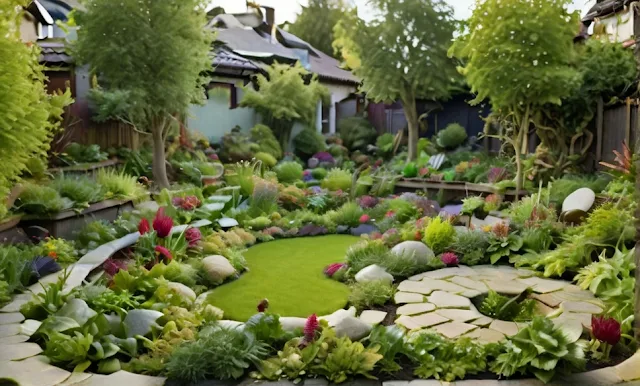When it comes to designing a garden, there are countless options to consider. From the layout and structure to the choice of plants and decorations, every aspect plays a crucial role in creating a space that reflects your personal style and meets your gardening goals. One of the first decisions to make when planning your garden is the layout, and there are two main approaches to consider: traditional and modern. In this article, we'll explore the characteristics of each type of garden layout and discuss the pros and cons of each.
Traditional Garden Layouts:
Traditional garden layouts are often inspired by classic English or cottage garden designs, characterized by a formal structure, symmetry, and a sense of orderliness. Some key features of traditional garden layouts include:
Symmetry: Traditional gardens typically have a symmetrical layout, with plants and features arranged in a balanced and orderly manner. Symmetry creates a sense of harmony and elegance in the garden, with focal points such as pathways, hedges, or statues placed centrally to create visual interest.
Formal Design Elements: Formal design elements such as geometric shapes, clipped hedges, and straight lines are common in traditional garden layouts. Boxwood or yew hedges are often used to define garden borders and pathways, while formal flower beds may feature neatly arranged rows of plants or geometric patterns.
Classic Plant Selection: Traditional gardens often feature a mix of classic plants such as roses, peonies, hydrangeas, and lavender, chosen for their timeless beauty and appeal. These plants are typically arranged in neat, well-defined beds or borders, with careful attention paid to color coordination and seasonal interest.
Focal Points and Features: Traditional gardens often include focal points or features such as statues, fountains, or arbors, designed to draw the eye and create visual interest. These features serve as focal points around which the rest of the garden is organized, adding structure and depth to the overall design.
Pros of Traditional Garden Layouts:
Timeless Elegance: Traditional garden layouts have a timeless appeal that never goes out of style.
Formal Structure: The symmetrical layout and formal design elements create a sense of orderliness and sophistication.
Classic Plant Selection: Traditional gardens feature a tried-and-true selection of plants known for their beauty and reliability.
Focal Points: Focal points and features add visual interest and serve as focal points around which the garden is organized.
Cons of Traditional Garden Layouts:
Maintenance Intensive: Traditional gardens can be labor-intensive to maintain, with regular pruning, deadheading, and grooming required to keep plants and features looking their best.
Limited Creativity: The formal structure of traditional garden layouts may limit creativity and personal expression compared to more modern designs.
High Cost: The cost of materials and maintenance for traditional garden features such as hedges, formal flower beds, and statuary can be higher compared to simpler, more modern designs.
Modern Garden Layouts:
Modern garden layouts, on the other hand, take a more contemporary approach to design, with an emphasis on simplicity, functionality, and sustainability. Some key features of modern garden layouts include:
Clean Lines and Minimalism: Modern gardens are characterized by clean lines, minimalistic design, and an uncluttered aesthetic. Straight pathways, geometric shapes, and simple plantings create a sense of openness and tranquility in the garden.
Natural Materials and Sustainable Design: Modern gardens often incorporate natural materials such as wood, stone, and metal, chosen for their durability and sustainability. Features such as rain gardens, green roofs, and native plantings are common in modern garden designs, reflecting a commitment to environmental stewardship and conservation.
Low Maintenance Plantings: Modern gardens typically feature low-maintenance plantings such as ornamental grasses, succulents, and drought-tolerant perennials. These plants require minimal water, pruning, and fertilization, making them ideal for busy homeowners or those looking to reduce their environmental impact.
Outdoor Living Spaces: Modern garden layouts often include outdoor living spaces such as patios, decks, or pergolas, designed for relaxation, entertainment, and enjoyment of the outdoors. These spaces may feature sleek, contemporary furniture, fire pits, or built-in seating areas, blurring the line between indoor and outdoor living.
Pros of Modern Garden Layouts:
Contemporary Aesthetic: Modern garden layouts offer a sleek, contemporary aesthetic that appeals to homeowners with a taste for minimalist design.
Sustainability: Modern gardens often incorporate sustainable design principles and eco-friendly materials, making them a greener choice for environmentally conscious gardeners.
Low Maintenance: The use of low-maintenance plantings and sustainable design features reduces the time and effort required to maintain a modern garden.
Outdoor Living Spaces: Modern garden layouts prioritize outdoor living spaces, creating inviting areas for relaxation, entertaining, and enjoying the outdoors.
Cons of Modern Garden Layouts:
Lack of Traditional Charm: Some gardeners may find modern garden layouts lacking the traditional charm and character of more formal, traditional designs.
Limited Plant Selection: Modern gardens may have a limited plant selection compared to traditional gardens, with an emphasis on low-maintenance, drought-tolerant species.
Initial Cost: The initial cost of materials and installation for features such as outdoor living spaces and sustainable design elements may be higher compared to more traditional garden layouts.
Choosing the Right Garden Layout for You:
Ultimately, the choice between traditional and modern garden layouts comes down to personal preference, lifestyle, and gardening goals. Whether you prefer the timeless elegance of a formal English garden or the sleek simplicity of a contemporary outdoor oasis, there's a garden layout to suit your style and needs. Consider factors such as maintenance requirements, budget, and available space when planning your garden, and don't be afraid to mix and match elements from both traditional and modern designs to create a unique and personalized outdoor space that reflects your personality and taste. With careful planning and creativity, you can create a garden that brings joy and beauty to your home for years to come.

